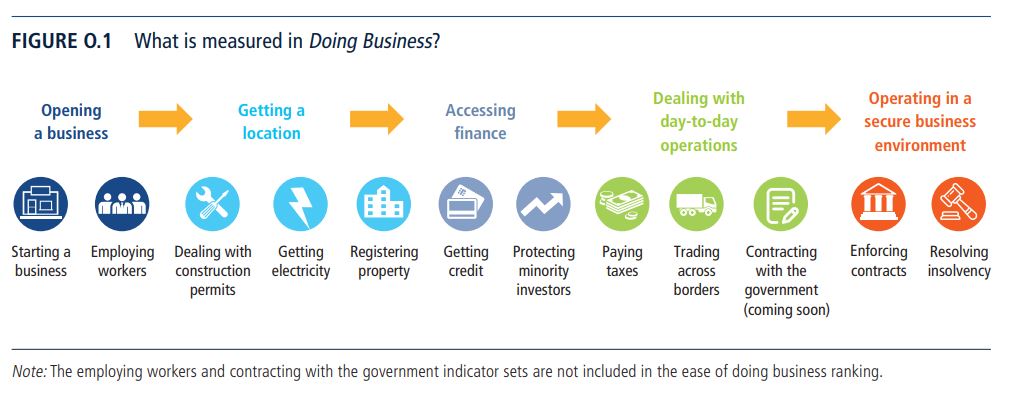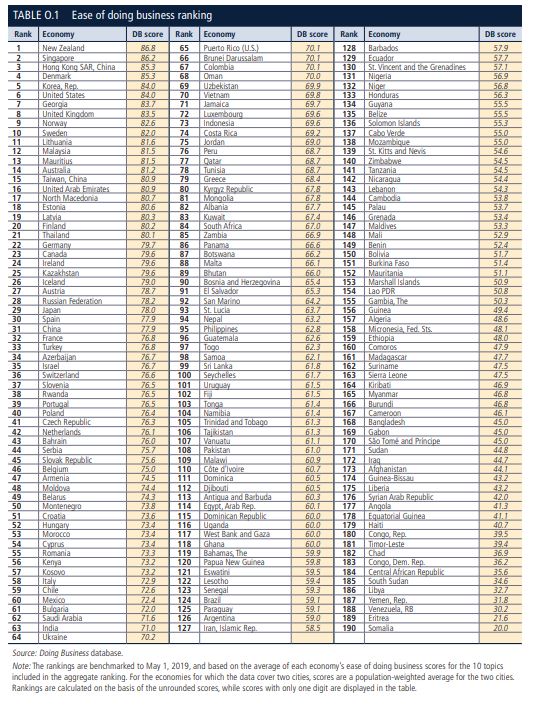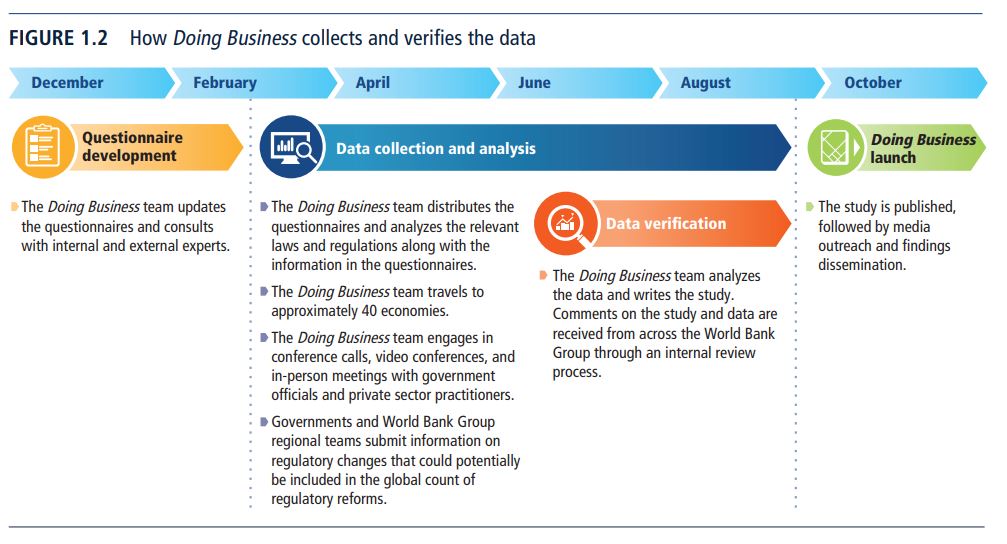What is the Doing Business project about?
The Doing Business project from the World Bank provides objective and quantitative measures of business regulations and their enforcement across 190 economies and selected cities at the subnational and regional levels, which serves as an important indicator for multinational companies when choosing potential economies to expand their businesses.
Data of the report focuses on 12 areas affecting small and medium-sized domestic firms in the largest business city of an economy, in which 10 areas’ performance are quantified to generate the ease of doing business score and ranking of an economy.
Details of the 12 areas being evaluated are shown below:
Most indicator sets refer to a case scenario in the largest business city of each economy, except for 11 economies that have a population of more than 100 million as of 2013. Those 11 economies also collected data for the second largest business city, where their scores and ranking reflect the population-weighted average for the 2 largest business cities.
●Subnational studies
In addition, Doing business offers detailed subnational studies, which exhaustively cover business regulation and reform in different cities and regions within a nation. These studies provide data on the ease of doing business, rank each location, and recommend reforms to improve performance in each of the indicator areas. Selected cities can compare their business regulations with other cities in the economy or region and with the 190 economies that have ranked.
What are the meanings of higher scores and rankings in Doing Business?
The ease of doing business score helps assess the absolute level of regulatory performance over time, which shows the distance of each economy from the best regulatory performance observed in each of the indicators across all economies in the sample since 2005 or the third year in which data were collected for the indicator. This approach underscores the gap between a particular economy’s performance and the best regulatory performance at any time.
The ranking on the ease of doing business complements the ease of doing business score by providing information about an economy’s performance in business regulation relative to the performance of other economies.
An economy’s ease of doing business score is reflected on a scale from 0 to 100, where 0 represents the lowest and 100 represents the best performance. The ease of doing business rankings ranges from 1 to 190. Below is the list recording the ranking and scores in 2019, according to which Hong Kong ranked the third out of 190 countries.
It should be noted that the economies that rank highest on the ease of doing business are not those where there is no regulation, but those where governments have managed to create rules that facilitate interactions in the marketplace without needlessly hindering the development of the private sector.
For example, below are some potential scenarios that get higher scores:
1. Protecting minority investors
-Higher scores are given for stricter disclosure requirements for related-party transactions.
2. Apply a risk-based approach to regulation as a way to address social and environmental concerns
-Higher scores are given for placing a greater regulatory burden on activities that pose a high risk to the population and a lesser one on lower-risk activities.
3. A simplified way of applying regulation that keeps compliance costs for firms low
-Higher scores are given for easing the burden of business start-up formalities with a one-stop shop or through a single online portal.
Data collection methods
The indicators are based mostly on laws and regulations, where approximately two-third of the data embedded in the Doing business indicators are based on a reading of the law. Some data are collected through several rounds of expert respondents, including both private sector practitioners and government officials, through responses to questionnaires, conference calls, written correspondence, and a visit by the team.
Four main sources of information for the report:
1. The relevant laws and regulations
2. Doing business respondents
3. The governments of the economies covered
4. The World Bank Group regional staff
Extensive consultations with multiple contributors, whose role is largely advisory on helping to locate and understand the laws and regulations, are conducted to minimize the measurement errors for some data. For example, on dealing with construction permits, enforcing contracts, and resolving insolvency, the time component and part of the cost component are based on actual practice rather than the law on the books.
To ensure a better estimate of time, Doing Business breaks down each process or transaction, such as starting a business or registering a property into separate steps. The time estimate for each step is given by practitioners who have significant and routine experience in the transaction.
Limitations of the measurements
The Doing Business methodology has at least five limitations that should be considered when interpreting the data:
1. The collected data refer to businesses in the largest business city and may not be representative of regulations in other parts of the economy.
2. The data often focus on a specific business form, which is generally a limited liability company of a specified size that may be not representative of the regulation on other businesses, such as proprietorships.
3. Transactions described in a standardized case scenario refer to a specific set of issues and may not represent the full set of issues that a business encounters.
4. The measures of time involve an element of judgment by the expert respondents. When sources indicate different estimates, the time indicators reported in Doing Business represent the median values of several responses given under the assumptions of the standardized case.
5. The methodology assumes that a business has full information on what is required and does not waste time when completing procedures.
In practice, completing a procedure may take longer if the business lacks information or is unable to follow up promptly. Alternatively, the business may choose to disregard some burdensome procedures.
Notes:
All of the graphs are quoted from and the content is composed according to the reports of Doing Business
References:
https://openknowledge.worldbank.org/bitstream/handle/10986/32436/9781464814402.pdf
https://www.doingbusiness.org/content/dam/doingBusiness/media/Profiles/Regional/DB2020/EAP.pdf
https://openknowledge.worldbank.org/bitstream/handle/10986/32436/211440app.pdf
Main findings of Doing Business 2020 report quoted from the World Bank website
- Doing Business captures 294 regulatory reforms implemented between May 2018 and May 2019. Worldwide, 115 economies made it easier to do business.
- The economies with the most notable improvement in Doing Business 2020 are Saudi Arabia, Jordan, Togo, Bahrain, Tajikistan, Pakistan, Kuwait, China, India and Nigeria. In 2018/19, these countries implemented one-fifth of all the reforms recorded worldwide.
- Economies in Sub-Saharan Africa and Latin America and the Caribbean continue to lag in terms of reforms. Only two Sub-Saharan African economies rank in the top 50 on the ease of doing business; no Latin American economies rank in this group.
- Doing Business 2020 continues to show a steady convergence between developing and developed economies, especially in the area of business incorporation. Since 2003/04, 178 economies have implemented 722 reforms captured by the starting a business indicator set, either reducing or eliminating barriers to entry.
- Those economies that score well on Doing Business tend to benefit from higher levels of entrepreneurial activity and lower levels of corruption.
- While economic reasons are the main drivers of reform, the advancement of neighboring economies provides an additional impetus for regulatory change.
- Twenty-six economies became less business-friendly, introducing 31 regulatory changes that stifle efficiency and quality of regulation.



